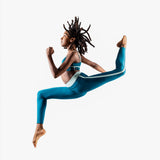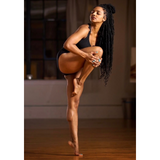Growing up as a ballet dancer, my teachers always told us that we were “artists.” At the time, I didn’t know what artistry was. Today, the best definition my husband and I can come up with and agree on is that art makes you “feel something.” I always felt “artist” was a title I hadn’t yet lived up to at such a young age (it wasn’t.) As ballet dancers, we learn technique, discipline, and repetition, among many other structured skills. All I had at my disposal as a young dancer in the pursuit of artistry were the tools of my methodical ballet training. I tried as best I could to use these tools I had been given to become an “artist.” Even at a young age, I knew there was a missing link. Try as I might, being my best “technical-self” did not equate to artistry.
I remember dancing the part of Clara in The Nutcracker around age 10, and being asked by my teachers to emote and connect with the audience among other things, but really never being given guidance as to how to achieve that connection. I was frustrated. I remember being even older, 17 and 18, and never feeling like I was “good enough” to loosen up and be expressive in my dancing. Did artistry mean making expressive faces, or exaggerating my port de bras? Could I only begin to be an artist once I was “good enough”? I wasn’t sure. After being admonished enough times by teachers throughout my life for not being “expressive” or “artistic,” I really began to wonder, what was the missing link between my technique and “artistry”?
I stopped my training at the age of 18 only to return to dance for a short time years later, so I can tell you, I still don’t have the answer. Had I continued with my training, it is possible that the missing link I sought would have become clear. But, it seems to me (I could be wrong) that many professional companies are a continuation of pre-professional training- daily class, rehearsal, and performances. In some cases, it seems, companies expect new, young members to be “artists” from the date of hire. I feel that many ballet dancers I know, myself included, specifically miss out on artistic training beyond technique, and beyond the physical aspect of lines and flexibility, unless they move on to university or a very nurturing company environment. (I can only speak from my own experience, so forgive me if you have experienced something different, and let me know in the comments!)
As a yoga teacher, I often ask myself- why is it that so often when we, as westerners, pursue any type of training, we focus mostly on the physical aspect, the movement itself, when there is so much depth to be explored? Yoga and the martial arts come to mind as my best examples. Yoga is an ancient spiritual practice, developed for very devoted practitioners who sought oneness with the divine. I am in absolute support of the evolution of religion and philosophy to match the times, especially since most people, (myself included) do not plan to devote their lives to yoga the way it was practiced thousands of years ago. Rather, we can draw from the aspects of the yoga philosophy that allow us to be better people in modern day life.
A 2016 study by Yoga Journal found that 36 million people in the U.S. practice or have practiced yoga. But in my experience, even those who have practiced yoga have often only practiced “asana” or postures (this observation is anecdotal, not scientific!) While asana is certainly part of yoga, that is not all there is. There are 8 limbs of yoga which include yamas- ethical standards niyamas- spiritual observances, asana- postures, pranayama- breathing, pratyahara- withdrawal or sensory transcendence, dharana- concentration, dhyana- meditation, samadhi-transcendence of self. Why is is that as westerners, we have chosen to focus so much on the physical postures? Why isn’t yoga philosophy beyond the physical not more ubiquitous in yoga classes? Why is the rest of the yoga philosophy (at least in my experience) virtually unknown to many who practice or have practiced?
I can’t really speak from experience for the martial arts as I do not practice any. But, based on anecdotal observation, the phenomenon of focusing on physical postures and movements with little overall interest in philosophy seems to permeate the martial arts in the west in a similar way it does yoga. There is such a rich history and philosophy surrounding the martial arts (of which I am no expert), so my question remains- why is it that the physical postures and movements of these ancient spiritual and very philosophical practices from the east have become such a focus, if not THE focus in the west?
Have we done the same with dance? Depth, including artistry, spirituality, connection, expression, commentary- have we ignored it in pursuit of the perfect arabesque line? I do not mean to say that focusing on the physical is a “bad” thing. I believe in technique and discipline as important developmental tools on the way to artistry, and of course I have the utmost respect and appreciation for beautiful lines. But, I am interested in the why behind the overall lack of interest in philosophy, spirituality, and intention behind what many of us are doing in our everyday lives, whether it be dance, yoga, or the martial arts. And, of course there are exceptions. Plenty of people are interested in these ideas! I just mean to comment about the sweeping popularity of physical movement when it comes to these practices. I am sure many martial arts teachers have a focus on philosophy and intention behind “fighting” or “not fighting” (forgive me if I am ignorant regarding the true intention of the martial arts). Likewise, there are many yoga teachers who incorporate the yoga philosophy as a whole into their classes, and I am sure many dance teachers share their own perspective regarding the pursuit of artistry.
When I first started practicing yoga, I wanted to know what the missing link was between doing postures on my mat and becoming a kind and compassionate person. Sri K. Patthabi Jois, a renowned yoga guru and the creator of the ashtanga yoga method, said that yoga is “99% practice, 1% theory.” There it is, the theory. Yoga philosophy and theory are available to us if we chose to learn. At least for me, it wasn’t until I started to delve into the yoga philosophy that I really began to understand what I was doing there on my mat. This is not to say that I 100% agree with everything I read about yoga philosophy. Much of it I find to be out dated and irrelevant to me as a woman in 2017. But, through the process of ongoing study, I have been able to pick out the aspects of yoga that most resonate with me, which started me on my journey to forge my own spiritual path, guided, but not controlled by yogic text and philosophy. The postures were not “goals” or “ends,” rather, they were tools that I could use to observe my own mind and my own tendencies and patterns. The way I approach the postures, react to the postures, and feel emotionally in the postures, is a reflection of myself off of the mat in my everyday life. Yoga is the pursuit of truth in that we aim to clear our own lens of bias to see things and ourselves as we truly are.
That insight did not pop up one day out of nowhere. It came through intent study, reading, learning from teachers and other students who shared their own revelations with me, and through constantly seeking answers. The pursuit of truth in yoga might be considered the main intention of the practice by some, so I will equate it to the pursuit of artistry in dance. The pursuit of these things is work. It’s hours. It’s failures. It’s blood sweat and tears. It is vulnerability. It’s being wrong. It’s moving forward and leaving others behind. It’s being left behind while others move forward. It is so many things. It is scary to follow a path to deeper understanding, whether it be truth or artistry, and maybe that is why so many of us in the west chose physicality over Philosophy.
Studying yoga philosophy in the pursuit of truth gives us a predetermined set of tools to use on our path. The tools provided in yoga certainly aren’t the only way to pursue truth or enlightenment. Many spiritual practices provide a “way” or “path” to be followed. While we might disagree with one “way” or another, there are clear tools within these spiritual practices set forth with a hope that the practitioner can begin to know the “self” or the “truth,” or fulfill any variety of other spiritual intentions. These tools or tenets don’t have to be controlling, but they are there as a guide should we choose to use them on our journeys.
Could it be that study, connection with other students, teachers, and myself, and seeking deeper answers beyond the physical was the missing link to artistry as a dancer? It seems that what I was looking for as a young dancer was the “way.” Although I am not sure there is a dance “philosophy” or “way,” maybe there is an equivalent. Or, maybe we must create our own. Maybe in the pursuit of artistry, there is no guide for us, like there is in spiritual practice. If this is true, to become artists, we must venture out into the world of unknown territory and forge our own paths to make people “feel something.” If you have a different definition of art than my husband and me, maybe your journey as an artist would be the pursuit of expression that fulfills your own Definition.
Just like yoga philosophy, the depth is there in dance if one chooses to pursue it. It just seems that there is no pre-paved path for the pursuit. Maybe the pursuit of artistry through the uncharted territory of expression is “the way.” Maybe the decision to pursue something beyond the physical is artistry in and of itself. Maybe what is found in the uncharted territory is art.
It is possible that had I continued to seek answers, philosophize and forge my own path as an artist, my artistic-self would have appeared. Closing out this article, I am left with more questions than answers. I am still not sure how, as a dancer, one moves from technician to artist, as that is not a path I truly pursued. I wonder, what could have been a part of my own dance training that would have allowed me to seek deeper understanding as a young student, and led me down an artistic path rather than a purely technical one? What value does the pursuit of artistry have as a part of dance training today, where there is such focus on lines and flexibility? Should artistic guidance be given to young dancers similar to the guidance we would receive on a spiritual path- providing a “way” as determined by a teacher, that guides the student to find their own “way”? What tools could teachers provide their dancers with that would gently nudge them onto their own artistic paths? How can dancers forge their own paths?
If you are a dancer, leave your thoughts below. You are the future, your ideas matter.



